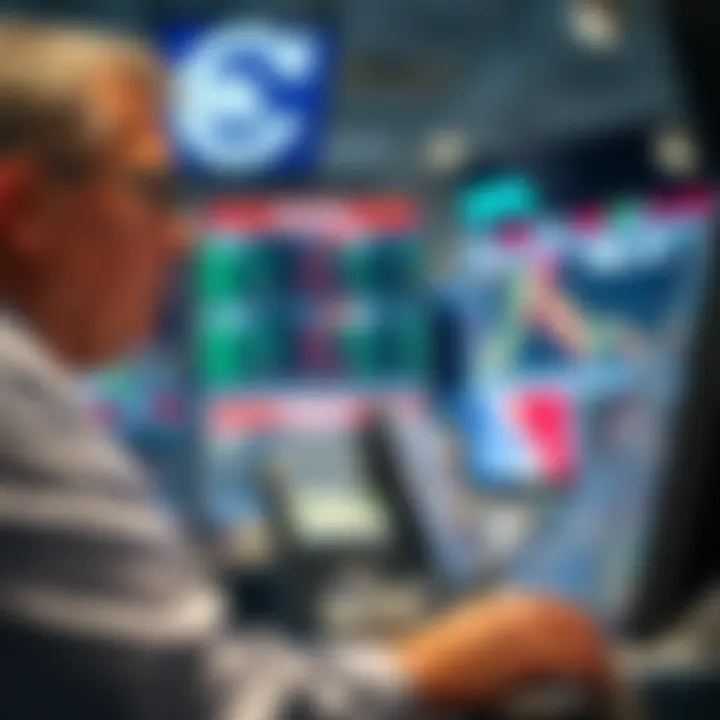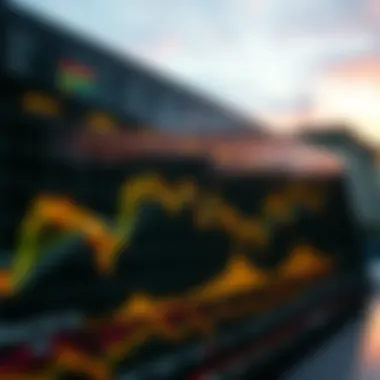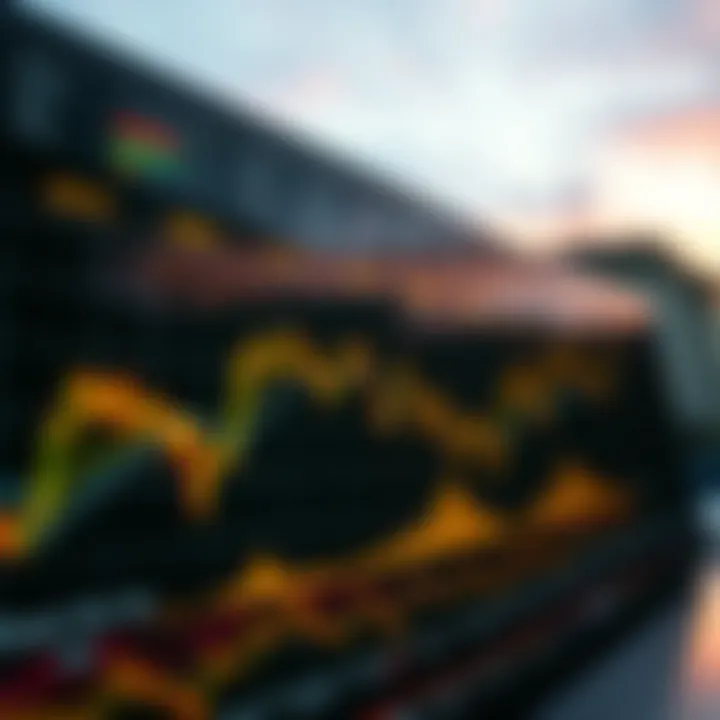Top Influential Futures Traders in History


Intro
The world of futures trading is a competitive arena where fortunes are made and lost in the blink of an eye. Traders in this field have an uncanny ability to foresee market shifts long before they hit mainstream news, employing a mix of sharp instincts, analytical skills, and psychological acumen. Understanding the journeys of the most successful futures traders offers aspiring investors and seasoned professionals alike a treasure trove of insights. Not only do their stories illuminate the strategies that clinched their success, they also provide lessons on resilience in the face of market turbulence.
In this article, we will delve into the lives and strategies of some of the most influential futures traders in history. From dissecting their trading philosophies to exploring how they adapted to ever-changing market conditions, this exploration will highlight the common traits that underpin their success. Through this journey, one key takeaway is clear: the path to profitability is often paved with knowledge, adaptability, and a few well-timed risks.
Intro to Futures Trading
Futures trading isn’t merely an activity; it’s a strategic maneuvering within the financial playground. The significance of understanding futures trading lies in grasping how these contracts can dictate the flow of various markets. Futures contracts serve as agreements to buy or sell an asset at a predetermined price at a specific date in the future. This is not just a theoretical exercise—it embodies real stakes in real time. For traders, grasping the intricacies of futures is akin to wielding a finely-tuned instrument, one which can either create symphonies of profit or lead to cacophonies of loss.
The beauty of futures is that they allow traders to hedge against potential price movements. It’s like having an insurance policy against unforeseen market fluctuations. Imagine you’re a farmer anticipating the harvest of corn—contracting to sell your yield at a set price can help secure your income, irrespective of the market’s whims. In this way, futures provide a layer of protection and predictability amidst the volatile nature of financial markets.
Moreover, futures trading enhances market liquidity—this means that assets can be bought and sold more easily, which is a considerable boon for investors. As players jump in and out, they not only facilitate transactions but also help discover prices. Think of it like a bustling marketplace; the more shoppers, the more vibrant the exchange. This dynamic is crucial for both short-term and long-term trading strategies.
Yet, it’s not all smooth sailing in the land of futures. The complexity surrounding margins, leverage, and risk management cannot be understated. New traders walking into this arena often find themselves like a deer caught in headlights. Understanding the foundational elements of futures contracts and their role within the grander landscape of financial markets is essential for constructing a sound trading strategy. By shining a light on these components, our exploration of the best futures traders aims to build a solid ground for appreciating their monumental achievements.
Understanding Futures Contracts
A futures contract is essentially a commitment—an agreement between two parties to transact an asset at a specific price on a future date. But what really sets it apart from other forms of trading? The answer lies in its unique structure and the characteristics that come with it. For example, futures are standardized, meaning that the contracts specify predetermined quantities and quality of the underlying asset. This uniformity simplifies trading on exchanges, making it a breeze to buy or sell without haggling over terms.
In the grand scheme of things, futures contracts can cover a wide range of assets, from commodities like wheat and oil to financial instruments like stock indices. This versatility allows traders to diversify their portfolios and exploit various market conditions. When the economy wobbles, savvy investors often turn to gold futures as a haven. Conversely, during growth periods, stock index futures may catch attention as traders seek to capitalize on upward momentum.
Another critical aspect is pricing. The futures price is influenced by a multitude of factors including supply and demand, geopolitical tensions, and even weather patterns. Traders must keep their finger on the pulse of these elements to navigate effectively. It's like being in a constant state of awareness—one sneeze in the right region can affect coffee prices globally.
Furthermore, futures contracts require a margin, which is a percentage of the contract’s value that must be deposited as collateral. This results in leveraging, where traders can control large positions with a relatively small amount of capital. However, this sword cuts both ways—the potential for significant profits comes hand in hand with the risk of substantial losses.
Thus, understanding futures contracts serves as a pivotal foundation for anyone engaged in futures trading. With a grasp over how they function, traders can strategically position themselves to seize opportunities while mitigating risks.
The Role of Futures in Financial Markets
Futures markets play a critical role in shaping financial landscapes. They act as a mechanism for price discovery and risk management within various sectors. When news breaks—be it a drought affecting crops or an oil embargo—futures markets respond almost instantaneously. They aggregate the collective insights and sentiments of market participants, thus reflecting expected future prices based on current information. This responsiveness is crucial not only for traders but also for businesses that depend on raw materials or commodities in their production processes.
In a way, futures trading serves as a barometer for economic sentiment. Watching how traders react can provide insights into how investors perceive broader economic conditions. Companies, institutions, and even governments rely on these insights to make informed decisions, whether that means adjusting their strategies to hedge against costs or planning production schedules.
Moreover, futures also provide opportunities for speculation. Traders seeking profit from price movements can engage in highly leveraged positions, betting on the direction of markets. While this can lead to significant gains for the astute, it also poses risks that can be catastrophic for those not well-versed in the game. It’s a tightrope walking act that demands discipline and acute market awareness—all while being subjected to the movements of forces beyond control.
Let’s not forget the historical significance. The establishment of futures markets such as the Chicago Board of Trade has revolutionized trading practices. Investors have gone from being mere spectators of price fluctuations to active participants who can influence those same prices. And as markets have evolved, so too have the strategies employed by traders—giving rise to more sophisticated and innovative approaches to tackling futures.
In sum, the role of futures in financial markets cannot be overstated. They serve as a bedrock for both hedgers and speculators, offering a platform where risk is exchanged and financial strategies are crafted. As we delve deeper into the journeys of remarkable futures traders, understanding this backdrop will illuminate the crucial impact these individuals have had on their respective markets.
Historical Context of Futures Trading
To grasp the current state of futures trading, it's essential to look into its backstory. The historical context of this field serves as a foundation for understanding how past events and developments have shaped the trading landscape we see today. A comprehension of the evolution of futures markets informs investors, analysts, and educators about the intricacies involved in trading these contracts. It also sheds light on the lessons that can be gleaned from historical figures whose strategies have been tested against the rigors of time.
Development of Futures Markets
Futures trading didn't spring up overnight; it has deep roots that trace back several centuries. In the early 17th century, the trend for futures contracts began to emerge in Japan with rice trading. Merchants would agree on prices for rice to be delivered in the future, paving the way for what we now identify as futures contracts.
Later, in the United States, the development of futures markets took a significant turn in the 19th century. The Chicago Board of Trade (CBOT) was established in 1848, marking a pivotal point in the trading of agricultural commodities. At that time, farmers and merchants needed a way to hedge against price fluctuations; futures contracts became the go-to solution. The importance of this evolution cannot be understated: it provided stability and predictability in an otherwise volatile market.
With the advent of modern technology and global interconnectedness, the futures markets continued to evolve. Today, you can trade futures on commodities like crude oil, gold, and even financial indices. This progression from local commodity exchanges to global platforms is essential to understanding the current futures landscape.
Landmark Events Shaping Futures Trading
Several landmark events have significantly influenced the sector, setting important precedents and shaping market structures.
- The Great Depression (1929): This financial crisis resulted in the introduction of regulations that aimed to stabilize the markets. The Commodity Exchange Act was passed in 1936, establishing a framework for overseeing futures trading and aiming to prevent the rigging of prices.
- The Introduction of Electronic Trading (1970s): The transition from open outcry to electronic trading revolutionized how futures contracts were traded. With electronic systems, traders could execute orders in milliseconds, increasing efficiency and market accessibility.
- The 2008 Financial Crisis: This event triggered a re-examination of risk management practices in futures trading. Regulatory bodies sought to impose stricter regulations on derivatives trading, including futures, to protect against systemic risks.
These pivotal moments in history offer valuable lessons about market resilience, regulatory frameworks, and the ever-present need for adaptability in an evolving economic landscape.
In summary, the historical context of futures trading is not just about dates and events; it's about understanding the underlying shifts that have influenced contemporary practices. From its origins in agricultural trading to its current global scope, the evolution of futures trading provides critical insights that both seasoned traders and novices can benefit from. By analyzing these developments, one can better appreciate the complexities and nuances of modern futures trading.
Criteria for Identifying Top Futures Traders


When we talk about the titans of futures trading, it’s vital to pinpoint what makes them stand out. The criteria for identifying top futures traders isn’t just about numbers or flashy profits; it runs deeper into personal traits, strategic acumen, and resilience in the face of adversity. Identifying these individuals requires looking at several specific elements that define their success.
Defining Success in Futures Trading
Success in futures trading can take on myriad forms, and while profit is undeniably an important yardstick, it’s often not the only one. Many traders achieve financial independence, while others may focus on mastery of their craft, exhibiting a high degree of skill and discipline.
- Consistency Over Time: A key element of success is the ability to generate profits consistently. The most revered traders succeed not just in one-off trades but over extended periods, navigating the ups and downs with steadiness.
- Risk Management: Those top-tier traders aren’t just gamblers; they know how to mitigate risk. Successful futures traders establish clear rules around position sizes, profit-taking, and stop-loss points. This foresight helps in minimizing losses when the market doesn’t play along.
- Adaptability: Markets are in a constant state of flux, and those traders who can adapt their strategies in response to new information or shifting market conditions often rise above their competition. Adaptability showcases a trader's ability to not just survive but thrive amid uncertainty.
- Mental Fortitude: Trading can be engrossing and emotionally taxing. High-performance traders demonstrate the capacity to manage stress well, maintaining emotional composure when the stakes are high. They seasoned themselves through experience, learning to differentiate between noise and meaningful signals.
Long-Term Impact and Legacy
Looking at the legacies of these futures trading legends can reveal insights that simply watching their trades can’t. Their influence transcends their bank accounts, shaping the trading community and the markets as a whole.
- Innovative Strategies: Many of these traders contributed to the evolution of trading strategies that are still taught today. For instance, Richard Dennis, with his Turtle Trading experiment, laid down a framework that has inspired countless traders by showing that trading can be a teachable skill.
- Mentorship and Influence: The contributions of iconic traders often extend beyond their own careers. They mentor up-and-coming traders, imparting knowledge that helps new generations. This has a ripple effect, as the principles and methodologies adopted by the mentored carry on the legacies of their mentors.
- Market Structures: Some traders have even influenced how futures markets are structured. Their trading techniques sometimes push for innovations in trading platforms or regulatory changes that enhance market efficiency and transparency.
- Cultural Impact: Beyond just finance, some futures traders become larger-than-life figures, influencing culture through books, interviews, and public speaking. Their stories often serve as cautionary tales or blueprints for aspiring traders.
"Trading is not about being right or wrong. It's about managing risk and staying in the game."
In essence, the criteria for identifying top futures traders hinge upon their financial success but also involve broader impacts on their disciplines. By examining traits like consistency, risk management, and adaptability, alongside their legacies, we can glean invaluable insights applicable to today’s trading environment.
Profiles of Iconic Futures Traders
Understanding the profiles of iconic futures traders is not merely an exploration of individual biographies; it's a deep dive into the strategies and philosophies that have shaped the very landscape of futures trading. These traders are often more than just successful; they are visionaries who have pushed the envelope of what’s possible in the markets. Their life stories, replete with lessons learned from both successes and failures, provide aspiring traders with invaluable insights.
When examining these figures, we find threads of commonality—an ability to adapt, a keen understanding of market behavior, and an unwavering commitment to their unique trading principles. For instance, Richard Dennis’s experiment with the Turtle Traders reveals much about the learnable aspects of trading strategies, contrasting with George Soros's philosophical approach to market dynamics which emphasizes a broader macroeconomic view. Collectively, these profiles not only enrich our understanding of individual accomplishments but also serve as a guide for current and future traders.
Through their stories, we discover the necessity of resilience in uncertain markets and the importance of self-awareness in balancing risk and reward. As we dissect each of these titans of trading, we will gain a comprehensive understanding of what it takes to thrive in the challenging world of futures trading.
Richard Dennis: The Turtle Trader
Richard Dennis is perhaps best known for his unconventional approach to training traders through the Turtle Program, which he launched in the early 1980s. This initiative was grounded in Dennis’s belief that anyone could learn to trade successfully given the right education and framework. The results were indeed monumental.
Dennis took a group of individuals with varied backgrounds, from a naval officer to a teacher, and taught them a systematic approach to trading. The Turtles learned to establish rules for entering and exiting positions, managing risk, and maintaining discipline. Within a relatively short amount of time, these principles led to the Turtles collectively amassing profits reaching in the millions.
This experiment not only demonstrated Dennis's ability to capitalize on market trends but also highlighted crucial elements of successful trading: discipline, strategy, and adaptability. > "The market is always changing and a trader must be able to adapt accordingly."
In many ways, Dennis reshaped how traders viewed education and training in this field.
Paul Tudor Jones: Master of Market Timing
Standing out as a titan in the world of futures trading, Paul Tudor Jones is renowned for his market timing acumen, particularly his foresight into economic downturns. With a reputation built on precise analysis and nimble maneuvering, Jones has established himself as a vanguard of trading strategies.
Through his flagship firm, Tudor Investment Corp, he has become a multi-billionaire while also prioritizing philanthropic efforts. His ability to align a trading strategy with macroeconomic events—such as his predictions before the 1987 market crash—demonstrates his deep understanding of market dynamics. Jones emphasizes the importance of risk management and often references the necessity of having an exit plan in place, which he credits as pivotal to his success and longevity in trading.
The stories from his career provide practical insights into both market awareness and trading psychology, valuable lessons extracted from decades in high-stakes environments.
George Soros: The Quantum Fund
George Soros is more than a trader; he's a philosopher who has transformed the way many approach the markets. His Quantum Fund, under which he notably executed his famous bet against the British pound in 1992, showcases his deep economic insights and willingness to embrace high-risk opportunities.
Soros's unique perspective is not grounded solely in technical analysis but rather in his theory of reflexivity, wherein market participants impact market conditions. This has often led him to take contrarian positions, influenced by broader economic narratives rather than just price charts.
His approach stresses the importance of understanding the psychological elements at play in trading and decision-making. Soros’s successes, especially when he strategically navigates turbulent markets, offer a prime example of how critical mindset and belief systems can be to a trader's effectiveness.
Bruce Kovner: From Cab Driver to Billionaire
Bruce Kovner’s ascent from a New York City cab driver to a billionaire trader embodies the type of tenacity that resonates within the trading community. His story underscores the idea that success in trading is not predicated solely on pedigree or education, but rather on determination and learning.
Kovner's trading philosophy is deeply rooted in risk management—he famously stated that the key to trading is limiting losses. He has developed strategies that focus on macroeconomic analysis, often taking positions based on economic trends he observes.
His experiences demonstrate how one can find their niche within the vast landscape of trading, proving that effective strategies can emerge from careful observation and a willingness to learn through trial and error.
David Tepper: Risk and Reward
David Tepper is often regarded as one of the most formidable hedge fund managers in the industry, well-known for the aggressive trading strategies employed at Appaloosa Management. His style revolves around taking significant risks, especially when he believes that specific market conditions are ripe for substantial profit.


Tepper gained widespread fame for his contrarian bets, notably during the economic downturn when many were selling off. His success often highlights the value of conviction in trading—understanding when to go against the grain can yield massive returns.
Additionally, Tepper has made headlines for his philanthropic disposition, demonstrating how traders can leverage their success for greater societal impact. His philosophy balances risk and reward, offering insights into the mindset necessary for high-stakes trading in volatile markets.
Key Strategies of Successful Futures Traders
Successful futures traders often stand out not only for their track records but also for their strategic approaches. Mastering the art of futures trading involves understanding complex dynamics in market behavior, leveraging sophisticated tools, and honing psychological resilience. In this chapter, we delve into essential strategies that have been adopted by some of the best in the field, shedding light on why these strategies are crucial and how they can be applied.
Risk Management Techniques
Risk management forms the backbone of any successful trading strategy. It involves planning and discipline, which allow traders to safeguard their capital while maximizing their potential for returns.
One proven technique is the stop-loss order, where traders set a predetermined level at which they will exit a trade to prevent significant losses. This prevents emotional decision-making that often leads to deeper financial pitfalls. Additionally, employing position sizing strategies helps in determining how much capital to allocate to individual trades, thus balancing risk across a portfolio. Another effective method is diversification, which means not putting all your eggs in one basket. By investing in a range of commodities or different futures contracts, traders can reduce overall risk, mitigating the impact of a loss in any single position.
"The best traders do not avoid risks but learn to manage them effectively."
Technical Analysis in Strategy Development
Using technical analysis enables traders to make informed decisions based on historical price movements and trading volumes. This form of analysis can serve as a compass when navigating the intricate world of futures trading. Key components of technical analysis include charts, patterns, and indicators.
Moving Averages, for example, help traders identify trends over time. Whether it's a simple moving average or an exponential one, these tools smooth out fluctuations, revealing clearer signals for buy or sell decisions. Additionally, Fibonacci retracements are particularly popular among traders, as they can indicate levels of support and resistance based on mathematical relationships.
In developing a strategic plan, utilizing technical analysis helps traders predict future price actions based on past behaviors. This foresight becomes invaluable for timing entries and exits in the market, shaping a more effective trading approach.
Psychological Aspects of Trading
The mental aspect of trading cannot be overlooked. Successful futures traders typically possess strong psychological fortitude. Influences such as market volatility can trigger various emotions, from anxiety to excitement, all of which can cloud decision-making.
Discipline is often cited as a trait shared among top traders. Adhering strictly to a pre-defined trading plan minimizes impulse trading decisions. Mindfulness practices can also benefit traders by fostering a calm mindset, allowing for clearer thinking during stressful situations.
Another vital psychological concept is self-reflection. Top traders frequently analyze their past trades, learning from both successes and failures. Adopting a growth mindset may help mitigate the fear of loss, reinforcing perseverance and fostering continual improvement.
In summary, the top strategies of successful futures traders encompass a combination of well-planned risk management, adept use of technical analysis, and strong psychological resilience. For traders aiming for success in this complex market, applying these strategies thoughtfully can significantly enhance their outcomes.
The Role of Innovation in Futures Trading
Innovation has always been a driving force in the world of futures trading. As traders seek to navigate the turbulent waters of the financial markets, they find themselves armed with new tools and strategies that allow them to thrive. The significance of innovation in this space cannot be overstated—it influences decision-making, enhances efficiency, and opens the door to opportunities that were once unimaginable. Understanding the role of innovation in futures trading helps illuminate not just how traders operate today, but also the evolving landscape of these markets.
The fast-paced nature of futures trading demands adaptability. As market conditions shift, so too must the techniques and technologies traders employ. Innovators in the field introduce concepts and mechanisms that can alter the very fabric of trading practices. Whether through algorithmic trading or breakthroughs in data analytics, these advancements push traders beyond traditional boundaries.
Innovations present distinct benefits that are crucial to consider:
- Increased Accessibility: New platforms democratize the space, empowering more individuals to participate in futures trading. The entry barriers are progressively lowered.
- Enhanced Efficiency: Cutting-edge technology streamlines processes, allowing traders to execute strategies faster than ever before.
- Better Analysis and Decision Making: Advanced data analytics provide traders with actionable insights, enabling informed decision-making in real-time.
- Risk Management Improvements: Innovative tools improve a trader's ability to manage risk, offering different ways to hedge positions and protect capital.
"The future belongs to those who believe in the beauty of their dreams." — Eleanor Roosevelt
In the sphere of futures trading, dreaming big often translates into groundbreaking advancements.
The call for constant innovation is not merely a suggestion; it's a necessity in today's markets. To remain competitive, traders must embrace new technologies and methodologies that can enhance their performance. The upcoming sections delve deeper into two critical aspects of this innovation: Technological Advancements in Trading and Algorithmic Trading and Its Impact.
Technological Advancements in Trading
With the advent of technology, futures trading has undergone a transformation that many traders of the past could hardly have envisioned. From digital trading platforms to advanced analytics tools, the evolution of technology has fundamentally altered how trades are executed and monitored. Today’s trader is not just a market participant; they often rely on cutting-edge technology to gain a competitive edge.
Key advancements include:
- Electronic Trading Platforms: Gone are the days of open-outcry systems. Platforms like the Chicago Mercantile Exchange and others have revolutionized the way trades are made, allowing quick, efficient transactions.
- High-Frequency Trading (HFT): This strategy leverages powerful algorithms to execute orders at extremely high speeds. It’s about making a large number of transactions in fractions of a second, capitalizing on minute discrepancies in prices.
- Data Analytics: Traders can now harness big data to predict market movements or understand trends that were previously too complex to analyze manually. The application of data science in trading provides insights that drive strategies.
- Mobile Trading Apps: Hand-held devices allow traders to manage their investments on the go, ensuring they can react promptly to market changes.
These advancements do not merely improve efficiency; they also help traders manage their strategies more effectively by offering real-time insights and automation.
Algorithmic Trading and Its Impact
Algorithmic trading represents one of the most significant innovations in futures trading. By using algorithms—sets of rules or instructions in code—traders can automate their trading strategies, making decisions based on predetermined criteria.
The impact of algorithmic trading can be profound:


- Speed and Precision: Algorithms can execute thousands of trades within seconds, which is simply unachievable for human traders. This speed can mean the difference between profit and loss, especially in volatile markets.
- Emotion-Free Trading: Removing human emotion from trading reduces the likelihood of rash decisions based on fear or greed. Algorithms stick to the plan, regardless of market conditions.
- Backtesting Strategies: Traders can use historical data to test the effectiveness of their strategies before deploying them in real-time. This process helps refine methods and eliminate untested approaches.
- Market Efficiency: Increased participation and trading speed improve price discovery in the futures markets, making them more efficient.
As we venture further into the nuances of futures trading, it's evident that innovation—particularly through technology and algorithmic processes—is reshaping the landscape. Embracing these changes not only positions traders at the forefront of the market but also enhances their capacity to respond to ever-evolving challenges.
Lessons Learned from the Best Futures Traders
The world of futures trading is a battleground where not just profits but valuable lessons are earned through hard experience. Understanding the methodologies and strategies that successful traders employed can shed light on what drives success in a volatile marketplace. These contributions evidently span beyond financial gain, highlighting the significance of agility, discipline, and mental fortitude. The traders who've made their mark have numerous insights, each one a stepping stone toward a better grasp of market dynamics.
Adapting to Market Conditions
Navigating the ever-changing landscape of futures markets requires an adaptive mindset. Iconic traders have demonstrated that sticking to a rigid strategy can often lead to financial ruin. For example, consider how Richard Dennis adjusted his approach to reflect shifting market conditions. His famed Turtle Trading System was not just about mechanical signals; it also incorporated principles of flexibility that allowed traders to respond to unforeseen circumstances effectively.
Here's why adaptability is crucial:
- Current Analysis: Always keep an eye on fresh data and trends. Prices can swing overnight; those who adjust quickly can sidestep disaster.
- Scenario Planning: By preparing for various market scenarios, traders can avoid being blindsided and make informed decisions inspired by predictions.
- Feedback Loops: Successful traders learn from prior outcomes—both victories and failures—to modify their strategies continuously. For instance, Paul Tudor Jones often emphasized the value of adjusting his strategies based on what the market teaches him.
Adapting means staying alive and thriving. Adopting a flexible approach isn’t merely about responding swiftly; it involves gauging the temperature of market sentiment and making the necessary pivots when required. The capacity to bend, not break, is what separates the wheat from the chaff.
Balancing Emotion and Logic
The realm of trading is as much about emotional intelligence as it is about number crunching. Many traders find themselves at crossroads where they must choose between instinct and analysis. Balancing these forces is an art that greats like George Soros have mastered over time.
A few key components of this emotional logic balance include:
- Self-awareness: Recognizing one’s emotional triggers can prevent knee-jerk reactions. Fluctuations in positions can spark emotions, but being conscious of your feelings leads to better decision-making.
- Discipline: It’s tempting to chase after losses or hold onto winning trades too long. Creating strict rules around entry and exit points can lend necessary structure.
- Confidence through Knowledge: Becoming well-versed in market dynamics gives traders the assurance to stick with their strategies, even when emotions sway the decision-making process.
Traders like Bruce Kovner often advise keeping a level head amidst the chaos of the market. Recognizing when to go with your gut and when to rely on evidence is essential for achieving long-term success.
"The hardest thing for a trader to do is to accept that they are wrong. But in every mistake lies an opportunity for growth."
Balancing emotional tendencies with analytical thinking is undoubtedly a tightrope walk. Yet, those who can maintain this equilibrium are usually those who flourish in the highs and lows of the trading arena.
Future of Futures Trading
The world of futures trading stands at a pivotal intersection of innovation and tradition. As the financial landscape continues to evolve, understanding the future of futures trading is essential. This section delves into emerging trends, key predictions, and critical considerations that will shape the trading arena moving forward.
Trends to Watch
- Increased Use of Artificial Intelligence: As technology progresses, artificial intelligence is making waves in the trading world. Algorithms can analyze vast amounts of data in seconds, identifying patterns that may be undetectable to human traders. This increased efficiency may lead to smarter trading decisions and more substantial profits.
- Expansion of ESG Investing: Environmental, social, and governance (ESG) investing isn't just a buzzword anymore. Futures traders are increasingly factoring ESG criteria into their decision-making processes. This trend may reshape the types of assets that are traded, emphasizing sustainability over short-term gains.
- Blockchain and Transparency: Blockchain technology brings an exciting prospect to futures trading. By enhancing transparency, blockchain can reduce fraud and increase trust in trading platforms. Traders, particularly in commodities, can anticipate clearer transaction records and lower costs associated with settlement processes.
- Rise of Retail Traders: The recent surge in retail trading platforms has democratized access to futures markets. As more individuals enter the trading space, there is a shifting emphasis on educational resources and community support. This trend will likely lead to diverse trading styles and increased market participation.
Predictions for Upcoming Market Dynamics
With an eye towards the future, several predictions can be made regarding market dynamics:
- Market Volatility: The next few years could see greater market volatility due to geopolitical tensions, climate change impacts, and economic fluctuations. Successful traders will need to develop robust risk management techniques to navigate this uncertainty.
- Integration of Augmented Reality: In the quest for better analysis, augmented reality may enter the futures trading landscape. Imagine wearing AR glasses, providing live data and charts overlaying the real world. It could revolutionize how traders analyze trends and make decisions.
- Customizable Futures Contracts: Traditional futures contracts might be tailored to meet specific needs. This flexibility can lead to increased participation from various sectors, allowing more nuanced hedging strategies and investment approaches.
"The future belongs to those who prepare for it today." - Malcolm X
For further engagement on futures trading topics:
- Check out more on market dynamics at Investopedia
- Join the community discussions on Reddit
- Enhance your understanding through resources available from CME Group
Culmination
Reflecting back on the pivotal role that exceptional futures traders have played in shaping the financial landscape, it's clear that their influence cannot be overstated. These pioneers have not only set standards for success but have also crafted strategies that still resonate within the market today. Their methodologies, philosophies, and choices serve as a blueprint for current and aspiring traders.
Reflecting on the Impact of Pioneers
Futures trading is often seen as a gamble, but the traders profiled in this article transformed it into a science grounded in discipline and analysis. Richard Dennis demonstrated how a structured approach and adherence to rules could yield profitable outcomes, effectively turning novices into adept traders through the Turtle Trading experiment. Paul Tudor Jones, with his acute sense for market directions, has inspired countless individuals to hone their intuition alongside technical indicators, reminding us that the human element remains vital in an industry driven by numbers.
George Soros, famously known for his bold market maneuvers, offered yet another perspective on risk management and speculative strategies. His foresight taught us that understanding global macroeconomic trends could be the difference between failure and success. Meanwhile, Bruce Kovner's journey from humble beginnings to billion-dollar success serves as a testament to the resilience and adaptability necessary in futures trading.
Each of these traders has etched their legacy in the sands of financial history, allowing us to glean insights that are applicable today. Their stories showcase key traits — adaptability, risk assessment, and an unyielding spirit — essential for navigating the ever-evolving market landscape.
Moving Forward in the Futures Market
As we look forward, the futures market continues to evolve, shaped by technological advancements and new trading paradigms. Algorithmic trading is on the rise, and today’s traders are using sophisticated tools to analyze data at lightning speed. However, the fundamental lessons from legendary traders remain timeless. Balancing technology with human intuition is critical. The infallible nature of market dynamics requires an understanding not just of numbers, but also of global events and psychological factors influencing traders’ behaviors.
In future, traders will need to stay abreast of emerging trends like decentralized trading platforms and the potential implications of cryptocurrency on futures markets. With volatility of the markets and geopolitical influences continually reshaping trading strategies, it's imperative for today’s traders to redefine their approaches, incorporating the sage advice drawn from the legends of the past while forging their own paths.
The journey of futures trading blends innovation with the wisdom of those who have walked the path before. To sum up, acknowledging and learning from the great traders not only enhances one's skills but also provides a roadmap to achieving greater heights in the futures market.















